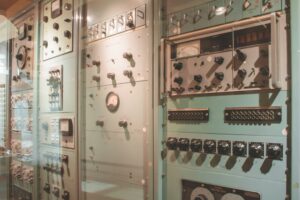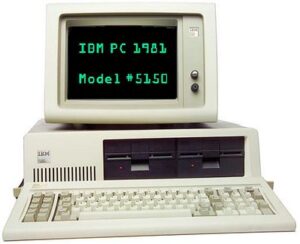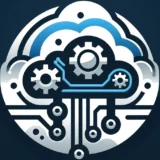Evolution of computers
Introduction
Imagine a world where a single computer costs as much as a luxury yacht, occupies an entire room and has less computing power than the watch on your wrist. Welcome to the 1940s, the dawn of the computing age, where the term “computer bug” literally meant finding moths in your room sized computer and debugging involved a can of insect repellent.
The journey from behemoth (pun intended) machines running simple calculations to pocket-sized supercomputers connecting the globe is not just a tale of technological advancement; it’s a saga filled with innovation, rivalry and partnerships possible of restructuring how the entire world operates.
In the 1940s, it wasn’t in the realm of possibilities or even imagination that computers could fit in the palm of your hand, could connect to other computers across the world, would be used to find dates, and watch cat videos. Let’s take a look at some of the major points along this tech journey that revolutionized our world.


Dawn of computing about 1940s – 1950s
A “computer” of the 1940’s was much different from modern computers in many different ways; look, power, practicality, and operationally. Konrad Zuse was a German engineer that created one of the first electromechanical relay computers. For those unfamiliar, an electromechanical relay computer consists of switches which are opened and closed to control the flow of electric current. In turn, this allows the computer to execute instructions based on a binary system of zeroes and ones. Zuse’s Z3 was the first digital computer which used more than 2000 relays. Zuse’s Z3 was intended for general purposes, especially engineering calculations. Keep in mind that during this WWII was affecting the entire world and this also caused delays to Zuse’s work on developing the Z-series computers.
In fact, some of these early computers were used to help aid in breaking highly complex codes used by the Axis powers. For example, “Colossus”, designed by British engineers, was used to decrypt the Lorenz cipher. The technology used to create Colossus was different in that vacuum tubes were used in places of relays. The use of vacuum tubes allowed for greater efficiency because they can be switched on/off faster than relays could. Also, Colossus was not general purpose, but specialized in cryptanalysis and it was able to break the complex Lorenz cipher used by the German military.
There’s certainly a lot more to electromechanical relays, vacuum tubes, binary states, electron flow, and data processing so if you want to read more about it, let me know so I can post another article!
Microprocessor and transistor revolution 1950s – 1970s
Possibly due to its (now) microscopic size, the transistor is what I would call an unsung hero of the technological advancements of computers. The transistor replaced vacuum tubes and were smaller, more reliable and consumed less power. By the 1950s, they began to be incorporated into computers, leading to more compact and efficient machines.
Following suit, the microprocessor allowed for great strides in advancing computers because they allowed for miniaturization and improved efficiency, which was sorely needed considering computers were the size of refrigerators! A great example of how the microprocessor advanced computers is to use Intel’s 4004 chip which was a single integrated circuit that could handle about 60,000 instructions per second. It was released in 1970 and paved the way for future advancements in computing power and more importantly, affordability and accessibility.

Birth of Tech Titans and the home computer 1970s – 80s
There are a few small companies you may have heard of; IBM, Microsoft and Apple. Yes, I’m joking and these companies are titans of the tech world because of the early foundation they laid. IBM had been involved in building and developing computers and mainframes since the 1950’s mostly for government and business operations. In 1980 IBM contracted Microsoft to develop an operating system for IBM’s first personal computer for home use. ONE of the first operating systems (OS), MS-DOS found its way into many homes, followed by the OS most everyone is familiar with, Windows. The contract with IBM led Microsoft to become a Tech Titan of today’s modern world where it is a globally recognized brand and not just as an OS, but also other software.
Of course, there’s another name you have probably heard of, Apple. Not the delicious fruit (which is also their logo) but the other Tech Titan of today’s modern world. Apple began in the late 1970s and early 1980s when they produced one of the first mass-produced personal computers. Apple elevated their brand and reputation by introducing a graphical user interface AND a mouse. A mouse!! Apple’s gadgets today are a bit more exciting; iPod, iPhone and iPad are several that can be named, among others.

Internet age 1980s – 90s
Back in the glory days of jean jackets and cassette tapes, the 80s and 90s brought upon us an Internet age, where endless oceans of knowledge can be accessed at your fingers. Of course it didn’t start that way, as it was mainly used by the US Department of Defense, but was made public in the early 90s.
The power of the internet and all the devices it would connect was unfathomable at the time. When the IPv4 system was invented, researchers and developers at the time thought 4,294,967,296 would provide enough addresses for the entire world. But, did you know we’re running out of IPv4 addresses? They are considered a limited, valuable resource in the tech world, but that’s a topic for a different time. Nonetheless, the Internet shaped today’s world as we know it. The digital era we live in was created by Tim Berners-Lee, an English computer scientist who invented HTML, the URL system and HTTP protocol. So the next time you look up a cat video on YouTube, give a shout out to Tim.
Cloud revolution 2000~
Computers running in the cloud seems far-fetched and certainly a tale of fiction to someone in 1950, but it is in fact real. Well, maybe not the cloud part as it’s more of a misnomer. Cloud computing are servers (usually in a datacenter) that run 24/7 to serve content whether that is your cat video or software. The latter is exactly what Salesforce accomplished and is credited with pioneering cloud computing. Amazon Web Services (AWS) launched in 2022 and holds the largest market share for cloud computing followed by Microsoft and Google (Google Cloud Computing aka GCP).
Several technologies paved the way for these companies to offer cloud computing, namely the Internet coupled with high speed connections, virtualization and data center technologies (there are certainly other technologies, but just to name a few). Virtualization allows for creating virtual instances of computers and everything it comes with (OS, storage, networks, etc) to run on a computer. In essence, a computer that has several virtual computers running inside of it. These computers that run other virtual computers inside of it have incredibly powerful hardware which allows for dozens and sometimes hundreds of virtual computers to run. This means that they got hot, like REALLY hot. Which is why data center technological advancements were a core piece of cloud computing. With lots of computers running virtual computers inside of them, all under the same building, there’s a necessity to keep the building nice and cool :sunglasses:

Today (2024)
In conclusion, we’ve made incredible technological advancements from tubes to transistors, and microprocessors, personal computers, the Internet, and cloud computing. All of this took place in less than 100 years, which is absolutely mind blowing if you ask me. There have been some incredibly smart people and highly collaborative efforts that have helped build today’s digital era and I’m so glad to be a part of it so that I too can watch cute cat videos on YouTube.
This article was not meant to be an exhaustive overview of all the major turning points, inventions, creators and inventors, companies, and technologies. I do feel that the points covered in this article are sufficient in showing our technological advancements within the last 100 years. I encourage you to comment about any points I didn’t include or missed that you feel are notable so we can discuss! Alternatively, if you want to add what era, invention, or gadget was your favorite throughout the years, please comment!
01101000 01110101 01100111 01100010 01111001 01110100 01100101 01110011
